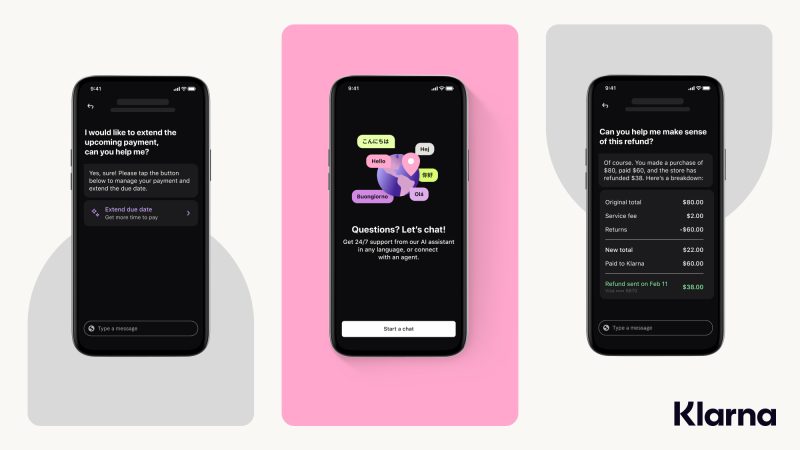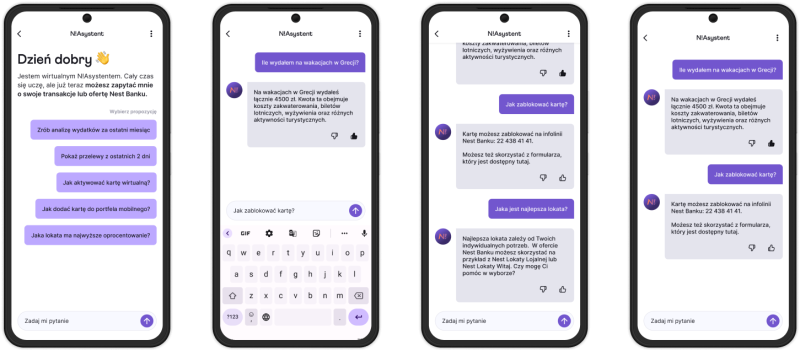AI chatbots in e-commerce are evolving along with the changes we’re seeing in how brands communicate with their customers. From simple automated responders that allow you to select a dialogue option to advanced artificial intelligence assistants, chatbots have changed the way businesses engage with customers. Read on to find out more.
AI chatbots for e-commerce – table of contents
Applications of AI chatbots in e-commerce
The value of generative AI used in e-commerce is expected to reach $2.1 billion by 2032, with a projected annual growth rate of 14.90% between 2023 and 2032 (https://marketresearch.biz/report/generative-ai-in-e-commerce-market/).
This rapid growth is primarily due to the wide range of applications of chatbots, which can significantly reduce the cost of doing digital business. In the context of e-commerce, chatbots are used in areas such as:
- customer service – chatbots can answer customer questions quickly and efficiently, reducing wait times,
- personalizing the shopping experience – by analyzing customer data, chatbots can offer personalized product recommendations. Amazon, using its Alexa voice assistant, suggests products based on a user’s previous purchases and preferences,
- order management – chatbots can also help track orders and inform customers of their delivery status,
- creating marketing content and product descriptions – chatbots are able to analyze visual and textual content and suggest interesting descriptions kept in the tone chosen by the seller.
These examples show how chatbots are making life easier for both customers and businesses, offering fast and convenient service. In the future, we can expect to see further development of these technologies, which will be even more customized, opening up new opportunities for the e-commerce sector.
Klarna
Klarna, a Swedish company that offers payment solutions for e-commerce, has revolutionized the industry by using chatbots to improve customer service. Known for its innovative approach to finance, Klarna uses artificial intelligence to provide its users with a seamless shopping experience.
Klarna uses chatbots mainly to:
- Automate customer service. In its first month of operation, Klarna’s AI assistant handled two-thirds of all customer service chats, the equivalent of 700 full-time agents. This shows how effectively chatbots can manage large numbers of queries, reducing the burden on employees and the company’s costs.
- Increase customer satisfaction. Klarna found that its AI assistant achieved customer satisfaction levels comparable to human agents and even contributed to a 25% reduction in repeat inquiries, thanks to greater accuracy in resolving issues.
Klarna is constantly striving to push the boundaries of fintech, and plans to continue using AI to streamline processes and provide an even better customer experience. This approach can inspire other companies looking for ways to use technology to optimize their services.

Source: Klarna (https://www.klarna.com/international/press/klarna-ai-assistant-handles-two-thirds-of-customer-service-chats-in-its-first-month/)
N!Asystent
N!Assistant, developed by Nest Bank, is another example of the innovative use of AI in the area of customer service. Using the GPT-4 language model from Microsoft, N!Assistant offers a new level of interaction, allowing users to communicate in natural language and perform advanced banking operations.
One of N!Assistant’s key features is natural language communication, which allows customers to have smooth, natural conversations with the chatbot, significantly improving the user experience. For example, a customer can ask about the best ways to save money, and N!Assistant will suggest products tailored to their financial needs.
N!Assistant is also about managing personal finances. It analyzes the client’s expenses and offers budget management tips to help better plan finances.
The potential of AI to improve customer interactions is enormous, and the example of N!Assistant shows how the technology can contribute to a more personalized and efficient service.

Source: Telepolis (https://www.telepolis.pl/fintech/taryfy-promocje-uslugi/nest-bank-n-asystent-gpt-4-microsoft-sztuczna-inteligencja)
Shopify
Shopify, an e-commerce platform, has had a significant impact on the way business owners sell online. With the integration of chatbots, Shopify offers tools to help manage the store and improve customer service, which is critical to success in the digital world. Chatbots in Shopify support:
- store management – Sidekick, a generative AI chatbot, helps store owners with various tasks such as setting discounts, summarizing sales data, and changing store designs. Sidekick is able to understand and answer questions about Shopify features and business management, greatly simplifying time-consuming and repetitive tasks,
- customer service – chatbots can answer customers’ frequently asked questions, offering quick and precise information to increase customer satisfaction and loyalty.
Feedback from Shopify users on the effectiveness of chatbots is positive. Business owners appreciate how Sidekick makes it easier to manage the store, which leads to better sales results and a higher level of customer satisfaction. Statistics and user testimonials confirm that integrating chatbots is beneficial for both sellers and their customers. The future of e-commerce platforms like Shopify seems to be closely tied to the advancement of AI, which opens up new opportunities for businesses to automate and personalize services.
Stitch
Stitch, a company that provides inventory management services, is using chatbots to innovate its processes. Using generative AI, Stitch is able to offer solutions that streamline the creation of marketing content and product descriptions, which are key to successful online sales.
Chatbots can create engaging ad headlines and product descriptions that match the tone of a brand’s communications. This significantly speeds up the content creation process and allows for better alignment of messaging with customer expectations.
Stitch’s innovative approach to using AI in inventory management can serve as a model for other companies looking for ways to optimize their operations.

Source: Stitch (https://multithreaded.stitchfix.com/blog/2023/03/06/expert-in-the-loop-generative-ai-at-stitch-fix/)
Etsy
Etsy, a global marketplace for creators and crafters, is effectively using chatbots to support its community of sellers and buyers. With advanced AI algorithms, Etsy offers features that make it easier to search and discover unique products.
Chatbots on Etsy support:
- image search – using image recognition technology (Computer Vision, CV) allows shoppers to search for products using photos, which is especially useful in the case of unique or handmade items,
- personalization of the shopping experience – AI algorithms analyze users’ preferences and behaviors, offering personalized product recommendations.
The role of AI in shaping online communities such as Etsy cannot be overstated. The technology enables the creation of more personalized and engaging shopping experiences, which contributes to building strong relationships between brands and their customers.

Source: Etsy (https://www.etsy.com/codeascraft/from-image-classification-to-multitask-modeling-building-etsys-search-by-image-feature)
AI chatbots for e-commerce – summary
In summary, chatbots are playing a key role in the transformation of e-commerce, providing businesses with tools to automate customer service, personalize the shopping experience, and optimize business processes. Innovations in AI and chatbot technology are opening up new opportunities for e-commerce, encouraging businesses to explore these solutions to increase competitiveness and customer satisfaction.

If you like our content, join our busy bees community on Facebook, Twitter, LinkedIn, Instagram, YouTube, Pinterest, TikTok.
Author: Robert Whitney
JavaScript expert and instructor who coaches IT departments. His main goal is to up-level team productivity by teaching others how to effectively cooperate while coding.
AI in business:
- Threats and opportunities of AI in business (part 1)
- Threats and opportunities of AI in business (part 2)
- AI applications in business - overview
- AI-assisted text chatbots
- Business NLP today and tomorrow
- The role of AI in business decision-making
- Scheduling social media posts. How can AI help?
- Automated social media posts
- New services and products operating with AI
- What are the weaknesses of my business idea? A brainstorming session with ChatGPT
- Using ChatGPT in business
- Synthetic actors. Top 3 AI video generators
- 3 useful AI graphic design tools. Generative AI in business
- 3 awesome AI writers you must try out today
- Exploring the power of AI in music creation
- Navigating new business opportunities with ChatGPT-4
- AI tools for the manager
- 6 awesome ChatGTP plugins that will make your life easier
- 3 grafików AI. Generatywna sztuczna inteligencja dla biznesu
- What is the future of AI according to McKinsey Global Institute?
- Artificial intelligence in business - Introduction
- What is NLP, or natural language processing in business
- Automatic document processing
- Google Translate vs DeepL. 5 applications of machine translation for business
- The operation and business applications of voicebots
- Virtual assistant technology, or how to talk to AI?
- What is Business Intelligence?
- Will artificial intelligence replace business analysts?
- How can artificial intelligence help with BPM?
- AI and social media – what do they say about us?
- Artificial intelligence in content management
- Creative AI of today and tomorrow
- Multimodal AI and its applications in business
- New interactions. How is AI changing the way we operate devices?
- RPA and APIs in a digital company
- The future job market and upcoming professions
- AI in EdTech. 3 examples of companies that used the potential of artificial intelligence
- Artificial intelligence and the environment. 3 AI solutions to help you build a sustainable business
- AI content detectors. Are they worth it?
- ChatGPT vs Bard vs Bing. Which AI chatbot is leading the race?
- Is chatbot AI a competitor to Google search?
- Effective ChatGPT Prompts for HR and Recruitment
- Prompt engineering. What does a prompt engineer do?
- AI Mockup generator. Top 4 tools
- AI and what else? Top technology trends for business in 2024
- AI and business ethics. Why you should invest in ethical solutions
- Meta AI. What should you know about Facebook and Instagram's AI-supported features?
- AI regulation. What do you need to know as an entrepreneur?
- 5 new uses of AI in business
- AI products and projects - how are they different from others?
- AI-assisted process automation. Where to start?
- How do you match an AI solution to a business problem?
- AI as an expert on your team
- AI team vs. division of roles
- How to choose a career field in AI?
- Is it always worth it to add artificial intelligence to the product development process?
- AI in HR: How recruitment automation affects HR and team development
- 6 most interesting AI tools in 2023
- 6 biggest business mishaps caused by AI
- What is the company's AI maturity analysis?
- AI for B2B personalization
- ChatGPT use cases. 18 examples of how to improve your business with ChatGPT in 2024
- Microlearning. A quick way to get new skills
- The most interesting AI implementations in companies in 2024
- What do artificial intelligence specialists do?
- What challenges does the AI project bring?
- Top 8 AI tools for business in 2024
- AI in CRM. What does AI change in CRM tools?
- The UE AI Act. How does Europe regulate the use of artificial intelligence
- Sora. How will realistic videos from OpenAI change business?
- Top 7 AI website builders
- No-code tools and AI innovations
- How much does using AI increase the productivity of your team?
- How to use ChatGTP for market research?
- How to broaden the reach of your AI marketing campaign?
- "We are all developers". How can citizen developers help your company?
- AI in transportation and logistics
- What business pain points can AI fix?
- Artificial intelligence in the media
- AI in banking and finance. Stripe, Monzo, and Grab
- AI in the travel industry
- How AI is fostering the birth of new technologies
- The revolution of AI in social media
- AI in e-commerce. Overview of global leaders
- Top 4 AI image creation tools
- Top 5 AI tools for data analysis
- AI strategy in your company - how to build it?
- Best AI courses – 6 awesome recommendations
- Optimizing social media listening with AI tools
- IoT + AI, or how to reduce energy costs in a company
- AI in logistics. 5 best tools
- GPT Store – an overview of the most interesting GPTs for business
- LLM, GPT, RAG... What do AI acronyms mean?
- AI robots – the future or present of business?
- What is the cost of implementing AI in a company?
- How can AI help in a freelancer’s career?
- Automating work and increasing productivity. A guide to AI for freelancers
- AI for startups – best tools
- Building a website with AI
- OpenAI, Midjourney, Anthropic, Hugging Face. Who is who in the world of AI?
- Eleven Labs and what else? The most promising AI startups
- Synthetic data and its importance for the development of your business
- Top AI search engines. Where to look for AI tools?
- Video AI. The latest AI video generators
- AI for managers. How AI can make your job easier
- What’s new in Google Gemini? Everything you need to know
- AI in Poland. Companies, meetings, and conferences
- AI calendar. How to optimize your time in a company?
- AI and the future of work. How to prepare your business for change?
- AI voice cloning for business. How to create personalized voice messages with AI?
- Fact-checking and AI hallucinations
- AI in recruitment – developing recruitment materials step-by-step
- Midjourney v6. Innovations in AI image generation
- AI in SMEs. How can SMEs compete with giants using AI?
- How is AI changing influencer marketing?
- Is AI really a threat to developers? Devin and Microsoft AutoDev
- AI chatbots for e-commerce. Case studies
- Best AI chatbots for ecommerce. Platforms
- How to stay on top of what's going on in the AI world?
- Taming AI. How to take the first steps to apply AI in your business?
- Perplexity, Bing Copilot, or You.com? Comparing AI search engines
- ReALM. A groundbreaking language model from Apple?
- AI experts in Poland
- Google Genie — a generative AI model that creates fully interactive worlds from images
- Automation or augmentation? Two approaches to AI in a company
- LLMOps, or how to effectively manage language models in an organization
- AI video generation. New horizons in video content production for businesses
- Best AI transcription tools. How to transform long recordings into concise summaries?
- Sentiment analysis with AI. How does it help drive change in business?
- The role of AI in content moderation


















